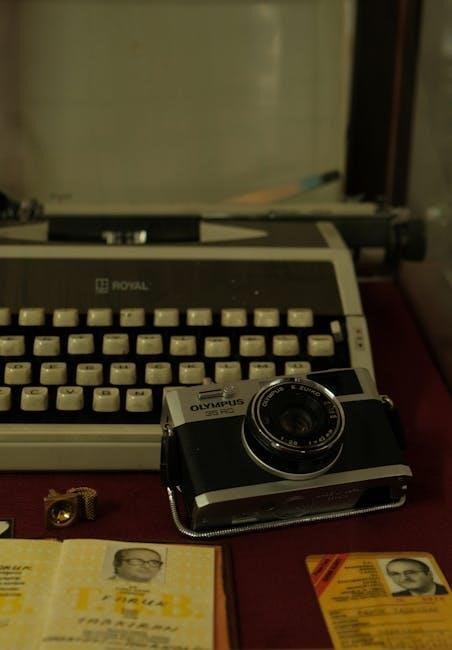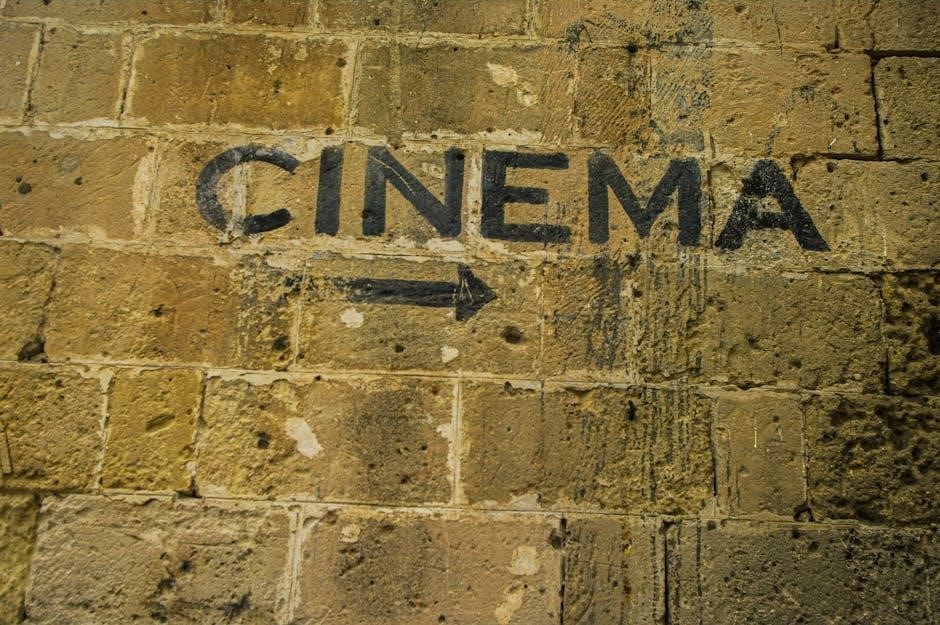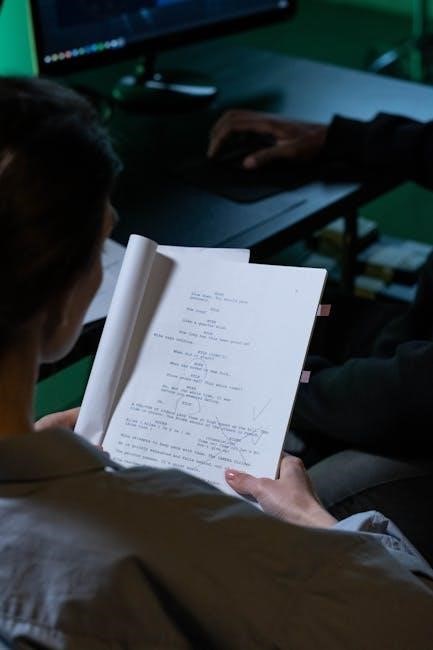
short guide to writing about film
Writing about film involves analyzing visual elements, sound, and narrative techniques to explore themes and meanings. It combines personal insights with critical thinking, balancing subjective opinions with objective analysis. A short guide offers practical tips for film analysis and screenwriting, helping readers develop their unique voice and storytelling skills effectively.
1.1. Understanding the Importance of Film Analysis
Film analysis is essential for uncovering deeper themes, exploring cultural context, and understanding cinematic techniques. It enables viewers to move beyond surface-level entertainment, engaging with films as meaningful texts. By examining visual elements, sound, and storytelling, analysts can interpret how films reflect and shape societal attitudes. This process fosters critical thinking and enhances appreciation for cinema as an art form. Effective film analysis also provides tools for evaluating how filmmakers communicate ideas, making it a cornerstone of both academic and creative approaches to understanding and writing about film.
1.2. Developing a Critical Eye for Cinema
Cultivating a critical eye for cinema involves actively engaging with films, observing details, and questioning their purpose. It requires analyzing how visual elements, sound, and storytelling collectively create meaning. Practice by watching films attentively, noting patterns, and reflecting on your reactions. Researching a film’s context, such as its historical background or director’s intent, enriches your understanding. Over time, this skill helps you discern quality, identify themes, and articulate your observations clearly. Developing a critical eye transforms passive viewing into an insightful, enriching experience, essential for writing about film with depth and clarity.
1.3. Key Skills Required for Film Writing
Effective film writing demands a combination of critical thinking, creativity, and technical skills. Strong analytical abilities are essential for interpreting themes, characters, and cinematic techniques. Clear and concise communication helps convey ideas persuasively. Research skills are vital for understanding context, such as a director’s intent or historical background. Familiarity with storytelling principles, like structure and pacing, enhances your analysis. Additionally, attention to detail ensures accurate observations, while organizational skills help present your ideas coherently. Balancing subjective interpretation with objective analysis allows for well-rounded, insightful writing about film.

Key Elements of Film to Analyze
Focus on visual elements like mise-en-scène and framing, sound and music, storytelling techniques, and editing. These components shape the narrative and viewer experience, offering deep insights into the film’s meaning.
2.1. Visual Elements: Mise-en-Scène, Framing, and Composition
Visual elements are crucial in film analysis, as they convey themes and emotions. Mise-en-scène refers to the arrangement of everything within the frame, including sets, costumes, and lighting, which collectively create the film’s atmosphere. Framing focuses on how scenes are composed, guiding the audience’s attention to specific details. Composition involves the balance of visual elements to evoke mood or symbolism. Analyzing these aspects helps uncover the director’s intent and enhances understanding of the narrative. Paying attention to visual storytelling reveals how films communicate beyond dialogue, making it a vital part of critical film analysis and interpretation.

2;2. Sound and Music: Their Role in Enhancing Narrative
Sound and music are essential elements in filmmaking, enhancing the narrative by evoking emotions and setting tone. Dialogue and sound effects create realism, while music underscores mood and pacing. Sound design immerses audiences in the film’s world, guiding emotional responses. Music can foreshadow events or highlight themes, often becoming inseparable from the story. Analyzing sound and music reveals how they complement visuals, deepen character development, and reinforce the film’s message. Their careful integration is vital for creating a cohesive and impactful cinematic experience, making sound and music indispensable tools in storytelling and narrative enhancement.
2.3. Storytelling Techniques: Plot, Character Development, and Dialogue
Effective storytelling in film relies on a compelling plot, well-crafted characters, and meaningful dialogue. The plot structure engages audiences, guiding them through exposition, conflict, and resolution. Character development reveals growth and depth, making protagonists relatable and memorable. Dialogue serves as a tool for exposition, character insight, and thematic exploration. Together, these elements create a narrative that resonates emotionally and intellectually. Analyzing these storytelling techniques helps uncover how filmmakers convey themes, evoke empathy, and maintain viewer engagement, making them central to understanding and appreciating cinema as an art form.
2.4. Editing and Pacing: How They Shape the Viewer’s Experience
Editing and pacing are crucial in shaping the viewer’s experience, as they determine the rhythm and flow of a film. Effective editing involves selecting and arranging scenes to convey meaning, while pacing controls the speed at which the story unfolds. Proper pacing builds suspense, manages tension, and ensures emotional resonance. Editors use techniques like cutting, transitions, and sound design to enhance storytelling. Well-executed pacing keeps audiences engaged, guiding their attention and emotional responses. Together, editing and pacing transform raw footage into a cohesive narrative, making them essential tools for filmmakers to craft compelling and impactful cinematic experiences.

Practical Steps for Writing About Film
Writing about film requires active viewing, detailed note-taking, and research to capture key observations and understand the director’s intent and cultural context effectively.
3.1. Watching the Film: Tips for Active Viewing
Active viewing is essential for effective film analysis. Pay attention to visual elements like mise-en-scène, composition, and lighting, as well as sound and dialogue. Watch without distractions, pausing to analyze key scenes. Observe how characters interact and how the narrative unfolds. Note the pacing and tone, and how they contribute to the overall mood. Consider the director’s intent and cultural context. Taking mental or written notes during the viewing helps capture initial impressions and insights. Repeat viewings can deepen understanding, allowing you to uncover layers in the storytelling and themes. This process lays the foundation for a thoughtful and detailed analysis.
3.2. Taking Notes: Capturing Key Observations
Effective note-taking is crucial for film analysis. While watching, jot down observations about visual elements, sound, and narrative techniques. Focus on specific scenes, characters, and themes that stand out. Use bullet points or categories to organize your thoughts, ensuring clarity. Capture quotes, camera angles, and musical cues that resonate with the film’s message. Tools like Joyce’s Plot Clock can help structure your analysis. Review your notes post-viewing to identify patterns and insights. This practice enhances your ability to articulate your thoughts and supports a detailed, evidence-based analysis. Organized notes are the cornerstone of compelling film writing.
3.3. Researching Context: Director’s Intent, Historical Background, and Cultural Relevance
Researching context enriches your film analysis by uncovering the director’s intent, historical background, and cultural relevance. Investigate the filmmaker’s previous works, interviews, and statements to understand their vision. Explore the historical era and social climate in which the film was made, as these often shape themes and narratives. Consider cultural influences and how they resonate with diverse audiences. Use credible sources like scholarly articles, reviews, and documentaries to gather insights. This deeper understanding allows you to connect the film’s elements to broader societal and artistic contexts, enhancing your analysis with meaningful perspectives and interpretations.

Structuring Your Film Analysis
Structuring your film analysis involves a clear introduction, organized body paragraphs, and a concise conclusion. A strong thesis guides your argument, supported by film examples and analysis.
4;1. Crafting a Strong Thesis Statement
A strong thesis statement is the foundation of effective film analysis. It should be clear, focused, and arguable, guiding the entire essay. To craft it, identify the film’s central theme or director’s intent, then narrow your focus to a specific argument. Avoid overly broad statements; instead, make a unique claim supported by evidence. Ensure your thesis is concise and places readers in the right framework for understanding your analysis. A well-crafted thesis will align with your analysis and leave a lasting impression, making your argument compelling and memorable.
Effective film analysis requires a clear structure. Begin with an introduction that provides background on the film and states your thesis. The body should be divided into focused paragraphs, each analyzing specific elements like themes, characters, or cinematography, supported by evidence from the film. Conclude by summarizing your main points, restating your thesis, and reflecting on the film’s broader significance. This structure ensures logical flow, making your analysis coherent and engaging while maintaining a professional tone throughout your essay.
4.3. Using Examples from the Film to Support Your Argument
Using specific examples from the film is crucial to strengthen your analysis. Select scenes, dialogue, or visual elements that directly relate to your argument. Clearly describe these examples and explain how they support your thesis. For instance, analyze a scene’s mise-en-scène to illustrate a theme or discuss how a character’s dialogue reveals their motivation. Ensure examples are relevant and effectively integrated into your analysis. This approach validates your points and enhances the credibility of your argument, making your film analysis more engaging and persuasive for readers.

Common Mistakes to Avoid
Avoid common mistakes like overly subjective opinions without evidence and excessive plot summarization. Focus on balanced analysis and thematic exploration to enhance your film writing’s credibility and depth.
5.1. Overly Subjective Opinions Without Evidence
One common mistake in film writing is relying too heavily on subjective opinions without supporting evidence. Statements like “this film is boring” or “the acting is terrible” lack depth and credibility. To avoid this, always back your opinions with specific examples from the film, such as dialogue, scenes, or visual elements. This approach strengthens your argument and makes your analysis more persuasive. Additionally, grounding your critique in observable elements ensures your writing remains objective and focused on the film itself rather than personal biases. This balance is key to producing insightful and professional film analysis.
5.2. Focusing Too Much on Plot Summary
Avoid dedicating too much of your analysis to recounting the plot, as this adds little value to your critique. Instead of summarizing events, focus on interpreting the film’s themes, techniques, and emotional resonance. Use specific scenes or dialogue to illustrate your points, ensuring your analysis goes beyond surface-level description. This approach fosters a deeper understanding of the film and demonstrates your ability to think critically. By balancing plot context with insightful analysis, you create a more engaging and meaningful review that offers readers a fresh perspective on the film.

Writing About Specific Film Genres
Understanding genre conventions is key to analyzing films effectively. Each genre, like horror or comedy, has unique elements that shape storytelling and audience expectations, enhancing your critique.

6.1. Analyzing Horror, Comedy, or Drama Films
Analyzing horror, comedy, or drama films requires understanding their unique conventions. Horror relies on suspense, visual tension, and sound to evoke fear. Comedy focuses on timing, dialogue, and absurdity to entertain. Drama emphasizes character depth and emotional storytelling. When critiquing these genres, consider how they manipulate audience emotions and expectations. For horror, examine how visuals and sound create unease. In comedy, analyze dialogue and pacing. In drama, explore character arcs and thematic resonance. Each genre offers distinct tools for storytelling, and recognizing these elements enhances your ability to write insightful, genre-specific critiques.
6.2. Understanding Genre Conventions and Their Impact
Genre conventions are standardized elements that define a genre, shaping audience expectations and narrative structures. Horror relies on suspense and visual motifs, while comedy uses timing and absurdity. Drama focuses on character depth and emotional arcs. These conventions guide storytelling, creating familiarity but also risking creative limits. Recognizing them enhances analysis, revealing how films adhere to or subvert expectations. Genre conventions evolve with cultural shifts, keeping genres fresh and relevant. Understanding these patterns provides a framework for critiquing a film’s effectiveness, helping writers and critics assess how well a film meets or challenges genre norms, ultimately enriching the dialogue about cinema and its diverse genres.

The Role of Cultural and Historical Context
Cultural and historical contexts influence film themes, character development, and settings, offering insights into societal values and events. These elements shape narratives, reflecting the director’s perspective and period.
7.1. How Social and Political Climate Influence Film Themes
Films often reflect the social and political climate of their time, addressing issues like inequality, freedom, or justice. Directors use narratives to comment on current events, societal norms, or historical struggles. For instance, movies produced during periods of political upheaval may highlight themes of resistance or conformity. Social movements, such as feminism or civil rights, inspire stories that amplify marginalized voices. The political climate shapes character development, dialogue, and visual styles, creating films that resonate with audiences on a deeper level. Cinema becomes a powerful tool for exploring and challenging the status quo, offering insights into the human experience shaped by its context.
7.2. Representing Diversity and Identity in Cinema
Cinema serves as a mirror reflecting diverse cultures, identities, and experiences. Films often highlight underrepresented voices, challenging stereotypes and fostering empathy. Authentic representation of race, gender, and sexuality enriches storytelling, offering audiences new perspectives. Characters from varied backgrounds encourage viewers to connect with experiences different from their own. By portraying real-world complexities, cinema promotes inclusivity and understanding. This reflection of diversity not only educates but also empowers marginalized communities, ensuring their stories are seen and heard. Through thoughtful representation, films can break down societal barriers and celebrate the richness of human identity in a way that resonates universally.

Resources for Film Writers
Explore recommended books, online courses, and screenwriting software to enhance your craft. Utilize tools like Final Draft and join writing communities for feedback and growth opportunities.
8.1. Recommended Books and Online Courses
Enhance your film writing skills with essential resources like The Writer’s Journey by Christopher Vogler and Save the Cat! by Blake Snyder. Online platforms like MasterClass and Coursera offer courses on screenwriting and film analysis. Websites such as Gotham Writers Workshop provide valuable insights and tips. Additionally, screenwriting software like Final Draft and Celtx can streamline your writing process. Joining online communities and forums dedicated to film writing fosters collaboration and growth. These tools collectively empower writers to refine their craft and produce compelling film analyses and scripts.
8.2. Using Screenwriting Software and Tools
Screenwriting software like Final Draft, Celtx, and Movie Magic Screenwriter simplifies scriptwriting by providing templates and formatting tools. These programs ensure industry-standard scripts, saving time and enhancing creativity. Features like story outlining, character development, and real-time collaboration are invaluable for writers. Additionally, tools like WriterDuet and StudioBinder offer free or affordable options with robust functionalities. Utilizing these resources helps streamline the writing process, allowing filmmakers to focus on storytelling and innovation. They are essential for both beginners and professionals, fostering efficiency and professionalism in film writing and production.
Writing about film is a rewarding journey that combines creativity with critical thinking. Persist in learning, practicing, and staying curious to refine your unique voice and storytelling skills.
9.1. Final Tips for Improving Your Film Writing Skills
To enhance your film writing, persist in learning and practicing. Rewatch films you admire, analyzing their structure and style. Take detailed notes to deepen your insights. Use screenwriting software to refine your scripts and explore storytelling techniques. Engage with fellow writers or join workshops for feedback and fresh perspectives. Read screenplays and film analyses to broaden your understanding. Most importantly, write regularly, experimenting with different genres and styles to develop your unique voice and master the craft of cinematic storytelling.
9.2. Encouragement to Keep Practicing and Learning
Improving your film writing skills takes time and dedication, but every effort is rewarding. Embrace challenges and view each project as an opportunity to grow. Seek feedback, learn from others, and stay curious about new techniques and perspectives. Celebrate small progress and remain persistent—consistent practice strengthens your craft. Surround yourself with resources, like books and online courses, to deepen your understanding. Remember, mastering film writing is a journey, and your passion for storytelling will shine through with commitment and patience.